Stressing State Analysis of Reinforced Concrete Beam Strengthened by CFRP Sheet with Anchoring Device
Abstract
1. Introduction
2. The Theory and Methods for Analyzing Structural Stressing State
2.1. The Concept of Structural Stressing State to of Beam Model
2.2. The Description and Modeling of Structural Stressing State
2.3. The Mann–Kendall Method
3. Experimental RC Beams
3.1. Configuration of Experimental RC Beams
3.2. Middle Anchorage and End Anchorage System
3.3. Loading Scheme and Arrangement of Measuring Points
4. Stressing State Analysis of RC Beam Strengthened with CFRP by Anchorage Device
4.1. Test Results and Load-deflection Curve Analysis
4.2. Characteristic Parameter of HG-1-12 RC Beam’s Stressing State
4.3. Investigation of Tested RC Beam’s Stressing State Mode
4.4. Stressing State Mode Analysis of RC Beams with Middle Anchorage
- For the RC beam numbered EG-1-0, after failure load, the bond force between the concrete and CFRP could not be effectively transferred to the ends of RC beam because of the peeling between these two materials. The strain of CFRP near the midspan section increases significantly, while the strain at the ends of CFRP sheet rises slowly. When the experimental RC beam is destroyed, the maximum strain value of the CFRP only reaches 6289 με, showing that the reinforcement effect of CFRP is not fully exerted and the composite action between CFRP and concrete is not fully exerted.
- Compared with the control beam (EG-1-0), the failure load of the RC beam with middle anchoring was improved to a certain extent. With the increase of the torsion applied to the anchoring device, the failure load of the RC beam also gradually increases, which indicates that the arrangement of middle anchorage on CFRP could effectively delay the peeling of the CFRP–concrete interface, thereby providing a firm mutual interaction between CFRP and concrete. The application of an anchoring device can give full play to the role of CFRP and further improve the bending performance of the tested reinforced concrete beam.
- Since the ability of the adhesive to transfer stress depends on its bond with the concrete and CFRP and the interfacial shear stresses, the scheme of setting middle anchorage on the CFRP could increase the positive stress and improve the bond force of interface, so that the CFRP sheet can be efficiently used near the ends. As shown in Figure 8, the maximum strain of CFRP of RC beams with middle anchorage is almost twice that of EG-1-0. In addition, as shown in Figure 8c, compared with other experimental RC beams, the CFRP strain distribution diagram of HG-1-6 represents the maximum utilization range of CFRP with high strain levels from point 2 to point 10.
4.5. Stressing State Mode Analysis of RC Beams with End Anchorage
5. The Application of Numerical Shape Function in the Stressing State Analysis of Experimental RC Beam
5.1. The Method of Numerical Shape Function
- As shown in Figure 10a, for the finite element model of RC beam’s midspan section was created with ANSYS 14.0 software. Shell 181 element is adopted for concrete with 5 mm in thickness and has an area of 5 × 5 mm2. Beam 188 element is used for CFRP in the simulation of cross-section. Its thickness is also 5 mm, and its length takes the real width of the CFRP sheet. Beam 188 element is also applied for longitudinal reinforcement. Its area takes the actual area of longitudinal reinforcement, and its thickness is 5 mm. In addition, the connection between reinforcement and concrete is assumed to be rigid. Strain values of 13 key points in the cross-section are measured as samples, to predict strain field of midspan section.
- Each shape function, Ni, of the i-th point (i = 1, 2, 3, …, 13) should be prepared in advance, to obtain the final interpolated field of each load step. For instance, as shown in Figure 10b, the shape function N2 of point 2 could be derived from finite element simulation by exerting displacement d = 1 at point 2, marked by a blue circle, and d = 0 at the other key points, marked by a red circle. Moreover, the form of N2 is , where N2(dj) is the simulated value at element node dj, and n is the total node of the cross-section. Moreover, Figure 10c shows the shape function of N13 obtained by the same steps.
- The interpolated field of cross-section model can be calculated by the linear combination of shape functions obtained above, as follows:where D is the interpolated field of cross-section model; ui is the measuring samples; m is the total number of measuring points, and it is 13 in this case.
5.2. Accuracy Verification of Expanded Experimental Data
5.3. Comparison between Curves Obtained by Two Methods
5.4. Analysis of Strain Fields’ Changing Characteristics
6. Conclusions
- For experimental specimens with middle anchorage, the strain distribution of CFRP was analyzed to evaluate the effect of torsion applied on the anchoring device on the reinforcement performance of the CFRP sheet. Combined with respective failure loads, its effect on the working behavior of RC beams can be further illustrated. In this study, when the torsion is set to 6 kN·m, the strain distribution of CFRP is more uniform, and its strengthening performance can be fully developed.
- For experimental specimens with end anchorage, through investigating the strain distribution of CFRP, the effect of deformation width of anchoring device on the reinforcement performance of CFRP sheet can be revealed. Then its effect on the RC beams’ working features can also be stated according to their failure loads. In this study, when the deformation width was set to 16 mm, the strengthening performance of CFRP was fully developed and greatly improved the ability of RC beams in resisting the bending moment.
- With the application of the NSF method, the limited strain data were reasonably expanded to further explore the changing features of strain field, which vividly revealed the changing characteristics of the RC beam’s stressing state. It also provided a new angle of view to predict sectional response information and conduct structural analysis.
Author Contributions
Funding
Institutional Review Board Statement
Informed Consent Statement
Data Availability Statement
Acknowledgments
Conflicts of Interest
References
- Spadea, G.; Bencardino, F.; Swamy, R.N. Structural Behavior of Composite RC Beams with Externally Bonded CFRP. J. Compos. Constr. 1998, 2, 132–137. [Google Scholar] [CrossRef]
- Aidoo, J.; Harries, K.A.; Petrou, M.F. Full-Scale Experimental Investigation of Repair of Reinforced Concrete Interstate Bridge Using CFRP Materials. J. Bridg. Eng. 2006, 11, 350–358. [Google Scholar] [CrossRef]
- Ceroni, F. Experimental performances of RC beams strengthened with FRP materials. Constr. Build. Mater. 2010, 24, 1547–1559. [Google Scholar] [CrossRef]
- Ashour, A.; El-Refaie, S.; Garrity, S. Flexural strengthening of RC continuous beams using CFRP laminates. Cem. Concr. Compos. 2004, 26, 765–775. [Google Scholar] [CrossRef]
- Toutanji, H.; Zhao, L.; Zhang, Y. Flexural behavior of reinforced concrete beams externally strengthened with CFRP sheets bonded with an inorganic matrix. Eng. Struct. 2006, 28, 557–566. [Google Scholar] [CrossRef]
- Mofidi, A.; Chaallal, O.; Benmokrane, B.; Neale, K. Performance of End-Anchorage Systems for RC Beams Strengthened in Shear with Epoxy-Bonded FRP. J. Compos. Constr. 2012, 16, 322–331. [Google Scholar] [CrossRef]
- Sayed-Ahmed, E.; Bakay, R.; Shrive, N. Bond strength of FRP laminates to concrete: State-of-the-art review. Electron. J. Struct. Eng. 2009, 9, 45–61. [Google Scholar]
- Hasnat, A.; Islam, M.M.; Amin, A.F.M.S. Enhancing the Debonding Strain Limit for CFRP-Strengthened RC Beams Using U-Clamps: Identification of Design Parameters. J. Compos. Constr. 2016, 20. [Google Scholar] [CrossRef]
- Sun, W.; Peng, X.; Yu, Y. Development of a simplified bond model used for simulating FRP strips bonded to concrete. Compos. Struct. 2017, 171, 462–472. [Google Scholar] [CrossRef]
- Miller, B.D. Bond between Carbon Fiber Reinforced Polymer Sheets and Concrete. Master’s Thesis, University of Missouri, Columbia, MO, USA, 1999. [Google Scholar]
- Aram, M.R.; Czaderski, C.; Motavalli, M. Debonding failure modes of flexural FRP-strengthened RC beams. Compos. Part B Eng. 2008, 39, 826–841. [Google Scholar] [CrossRef]
- Nguyen, D.M.; Chan, T.-K.; Cheong, H.K. Brittle Failure and Bond Development Length of CFRP-Concrete Beams. J. Compos. Constr. 2001, 5, 12–17. [Google Scholar] [CrossRef]
- Teng, J.G.; Chen, J.; Smith, S.T.; Lam, L. Behaviour and strength of FRP-strengthened RC structures: A state-of-the-art review. Proc. Inst. Civil Eng. Struct. Build. 2003, 156, 51–62. [Google Scholar] [CrossRef]
- Wu, Z.; Kim, Y.J.; Diab, H.; Wang, X. Recent Developments in Long-Term Performance of FRP Composites and FRP-Concrete Interface. Adv. Struct. Eng. 2010, 13, 891–903. [Google Scholar] [CrossRef]
- Ceroni, F.; Pecce, M.; Matthys, S.; Taerwe, L.R. Debonding strength and anchorage devices for reinforced concrete elements strengthened with FRP sheets. Compos. Part B Eng. 2008, 39, 429–441. [Google Scholar] [CrossRef]
- Mostofinejad, D.; Mahmoudabadi, E. Grooving as Alternative Method of Surface Preparation to Postpone Debonding of FRP Laminates in Concrete Beams. J. Compos. Constr. 2010, 14, 804–811. [Google Scholar] [CrossRef]
- Mostofinejad, D.; Shameli, S.M. Externally bonded reinforcement in grooves (EBRIG) technique to postpone debonding of FRP sheets in strengthened concrete beams. Constr. Build. Mater. 2013, 38, 751–758. [Google Scholar] [CrossRef]
- Rasheed, H.A.; Decker, B.R.; Esmaeily, A.; Peterman, R.J.; Melhem, H. The Influence of CFRP Anchorage on Achieving Sectional Flexural Capacity of Strengthened Concrete Beams. Fibers 2015, 3, 539–559. [Google Scholar] [CrossRef]
- Ferreira, M.; Oliveira, M.; Lima Neto, A.; Tapajós, L.; Nascimento, A.; Freire, M. Influence of anchorage on flexural strength of beams strengthened with CFRP sheets. Rev. ALCONPAT 2019, 9, 30–47. [Google Scholar]
- Benvenuti, E.; Orlando, N. Failure of FRP-strengthened SFRC beams through an effective mechanism-based regularized XFEM framework. Compos. Struct. 2017, 172, 345–358. [Google Scholar] [CrossRef]
- Benvenuti, E.; Orlando, N. Intermediate flexural detachment in FRP-plated concrete beams through a 3D mechanism-based regularized eXtended Finite Element Method. Compos. Part B Eng. 2018, 145, 281–293. [Google Scholar] [CrossRef]
- Barros, J.A.; Fortes, A. Flexural strengthening of concrete beams with CFRP laminates bonded into slits. Cem. Concr. Compos. 2005, 27, 471–480. [Google Scholar] [CrossRef]
- Esfahani, M.; Kianoush, M.; Tajari, A. Flexural behaviour of reinforced concrete beams strengthened by CFRP sheets. Eng. Struct. 2007, 29, 2428–2444. [Google Scholar] [CrossRef]
- Shi, J.; Li, W.; Zheng, K.; Yang, K.; Zhou, G. Experimental investigation into stressing state characteristics of large-curvature continuous steel box-girder bridge model. Constr. Build. Mater. 2018, 178, 574–583. [Google Scholar] [CrossRef]
- Zhou, G.C.; Rafiq, M.Y.; Bugmann, G.; Easterbrook, D.J. Cellular Automata Model for Predicting the Failure Pattern of Laterally Loaded Masonry Wall Panels. J. Comput. Civ. Eng. 2006, 20, 400–409. [Google Scholar] [CrossRef]
- Kendall, M.G. Rank correlation methods. Biometrika 1948, 298, 291–296. [Google Scholar] [CrossRef]
- Mann, H.B. Nonparametric tests against trend. Econometrica 1945, 13, 245–259. [Google Scholar] [CrossRef]
- Hirsch, R.M.; Slack, J.R.; Smith, R.A. Techniques of trend analysis for monthly water-quality data. Open-File Rep. 1981, 18, 107–121. [Google Scholar] [CrossRef]
- Chen, X. Study on Flexural and Shear Behavior of Reinforced Concrete Beams Strengthened with FRP. Master’s Thesis, Shenzhen University, Shenzhen, China, 2017. (In Chinese). [Google Scholar]
- GB/T 3354-2014. Test Method for Tensile Properties of Oriented Fiber Reinforced Polymer Matrix Composites; Standardization Administration of the People’s Republic of China: Beijing, China, 2014. [Google Scholar]
- ASTM D3039M-17. Standard Test Method for Tensile Properties of Polymer Matrix Composite Materials; ASTM International: West Conshohocken, PA, USA, 2008. [Google Scholar]
- Bonopera, M.; Chang, K.-C.; Chen, C.-C.; Sung, Y.-C.; Tullini, N. Prestress force effect on fundamental frequency and deflection shape of PCI beams. Struct. Eng. Mech. 2018, 67, 255–265. [Google Scholar]
- Bonopera, M.; Chang, K.; Chen, C.; Sung, Y.; Tullini, N. Experimental study on the fundamental frequency of prestressed concrete bridge beams with parabolic unbonded tendons. J. Sound Vib. 2019, 455, 150–160. [Google Scholar] [CrossRef]
- Li, J.; Heap, A.D. A review of comparative studies of spatial interpolation methods in environmental sciences: Performance and impact factors. Ecol. Inform. 2011, 6, 228–241. [Google Scholar] [CrossRef]
- Geisser, S. A predictive approach to the random effect model. Biometrika 1974, 61, 101–107. [Google Scholar] [CrossRef]

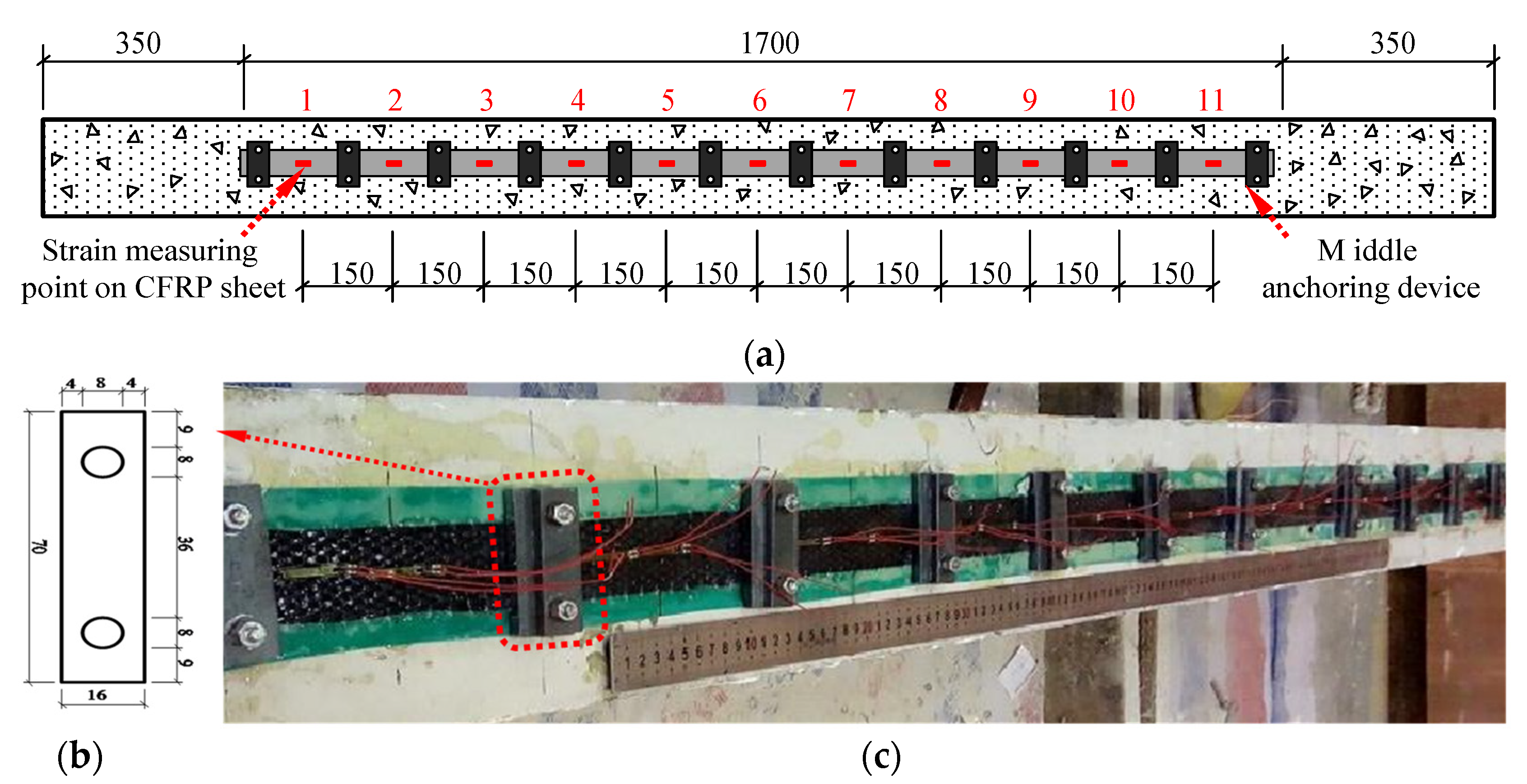

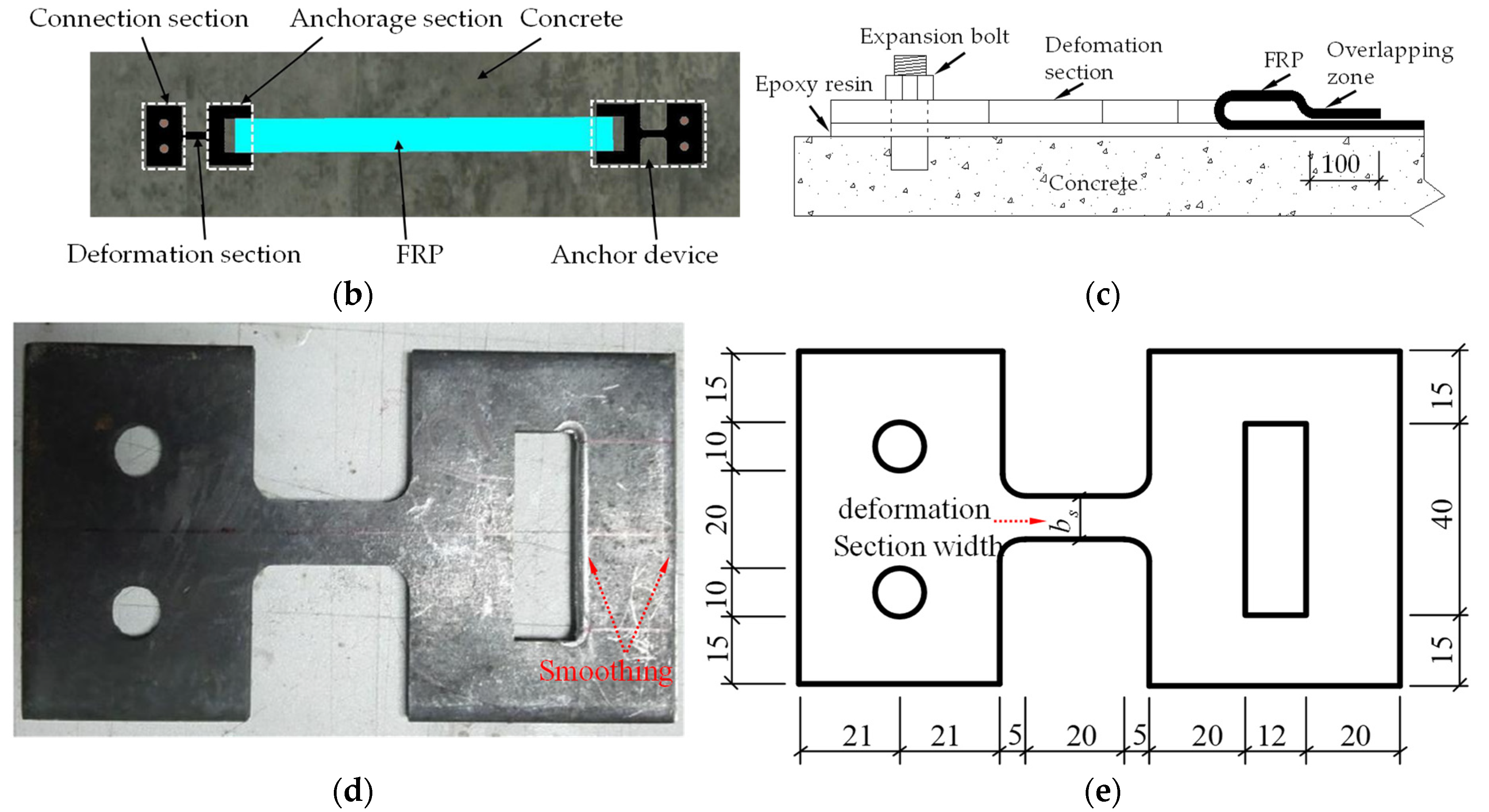
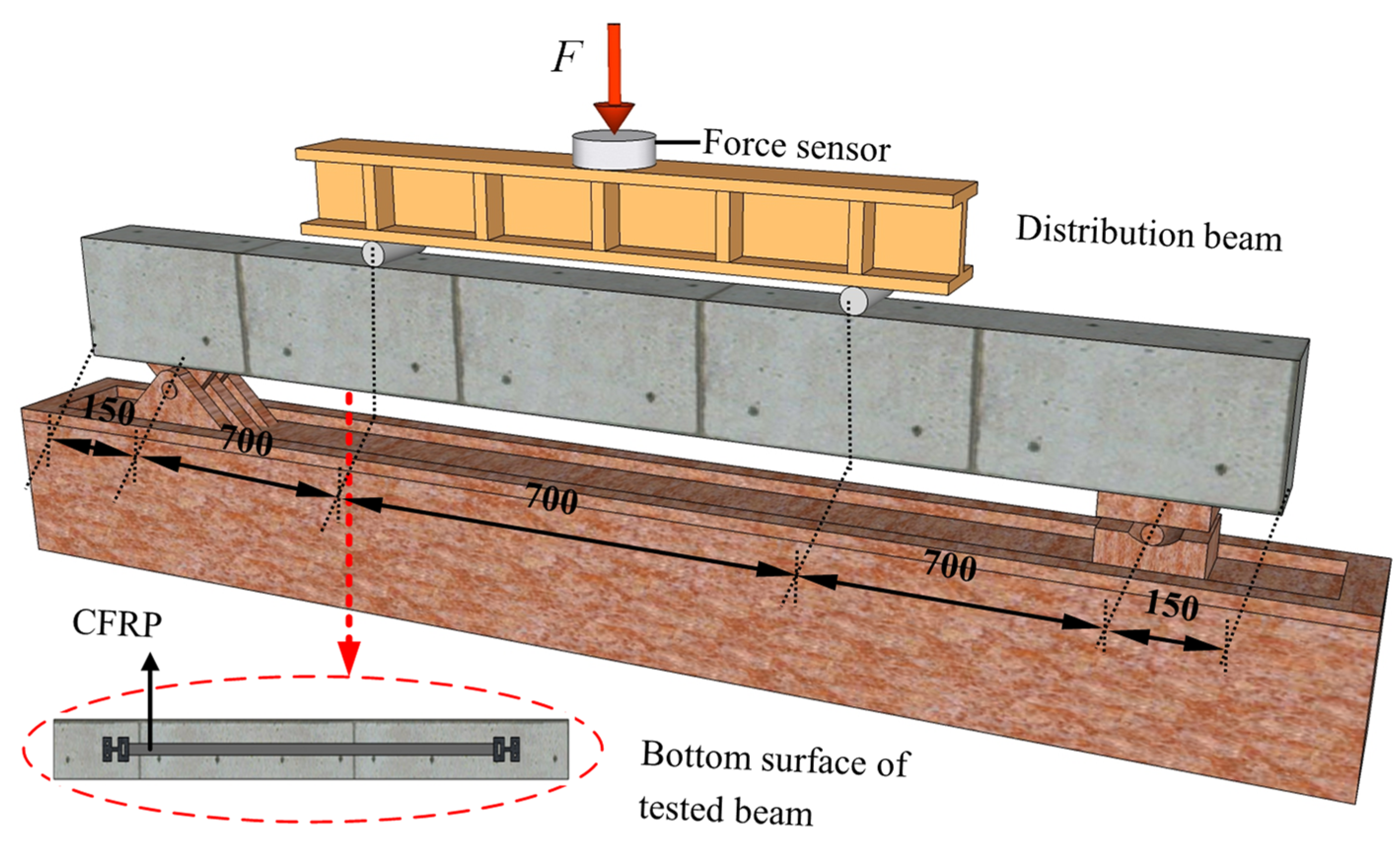
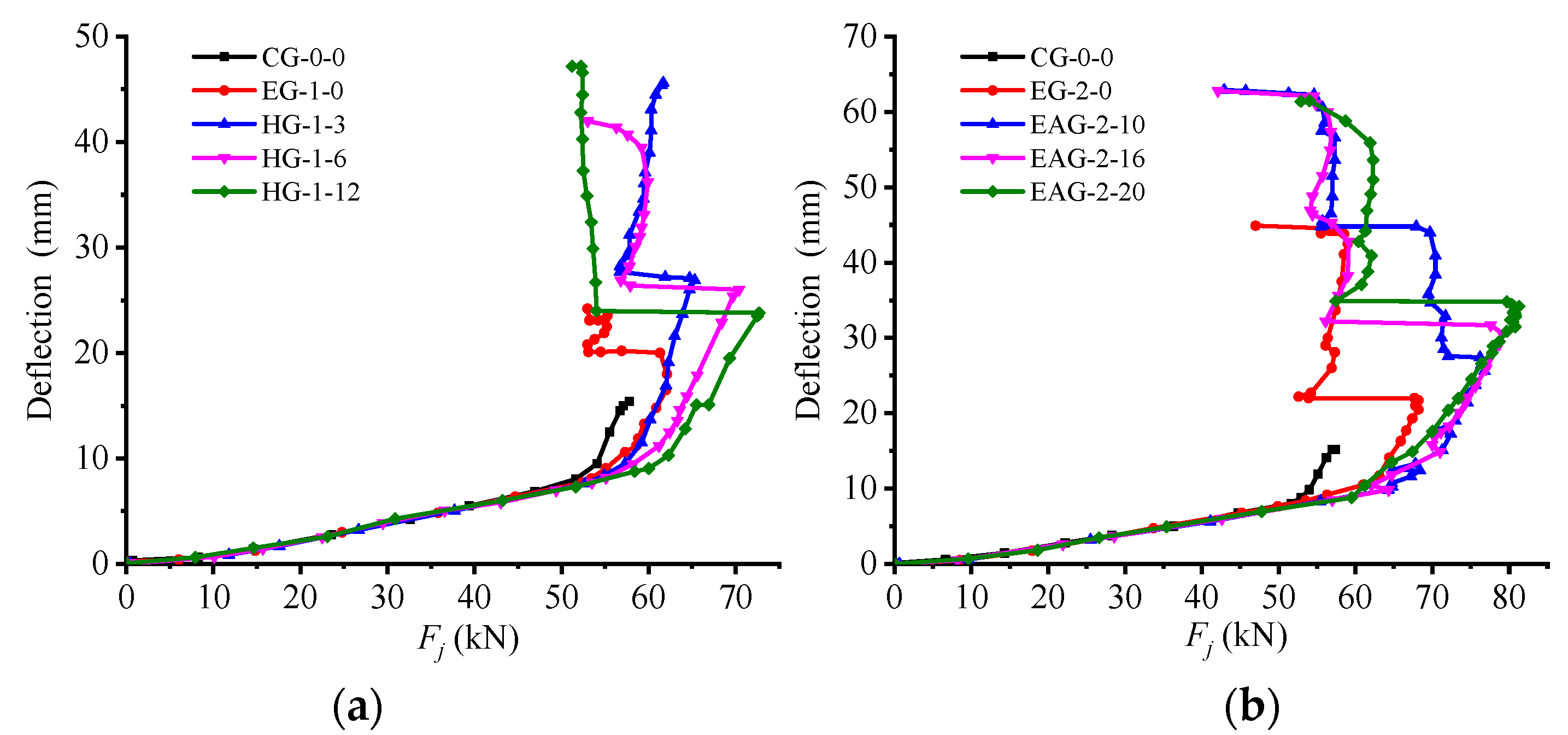
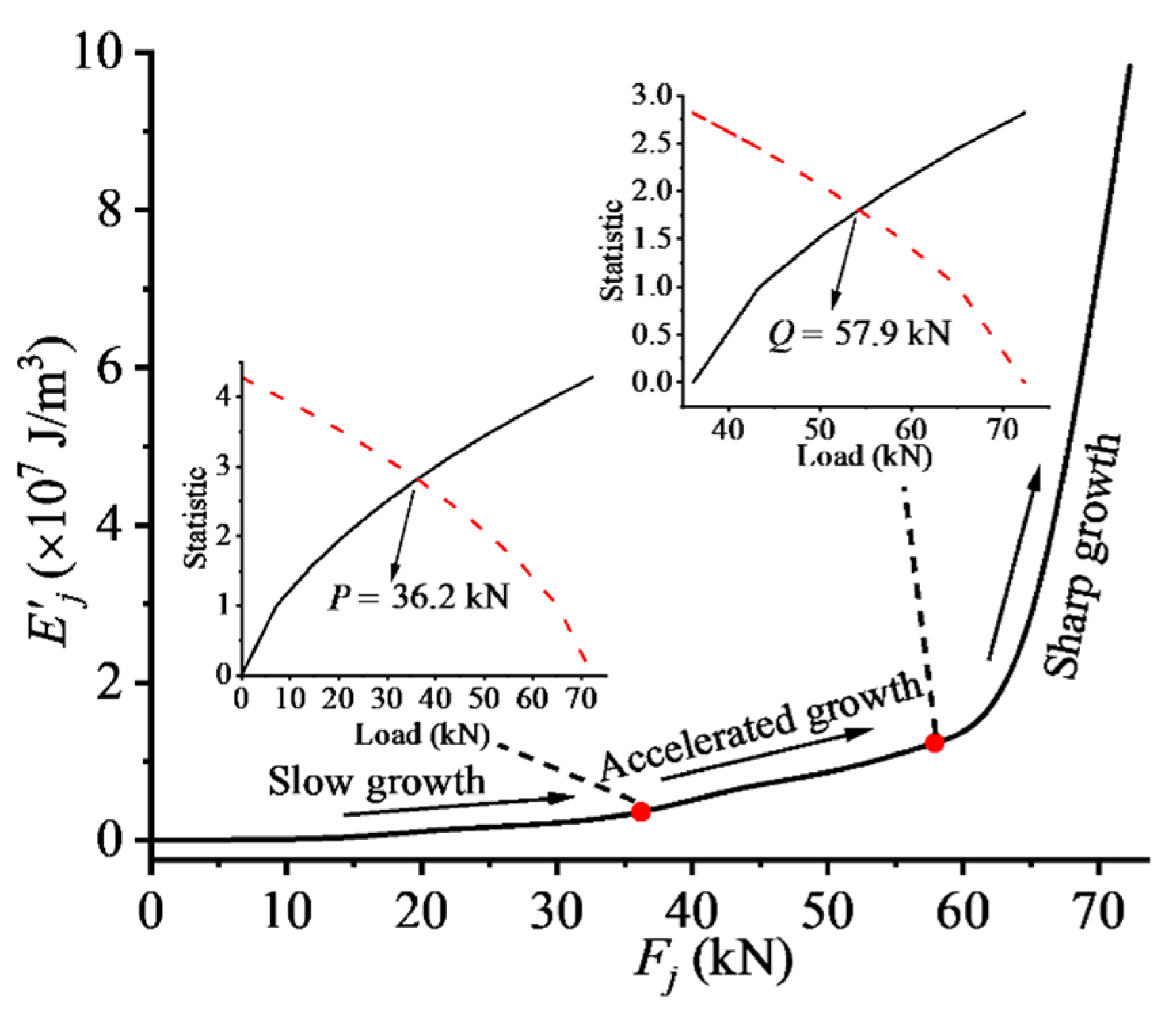


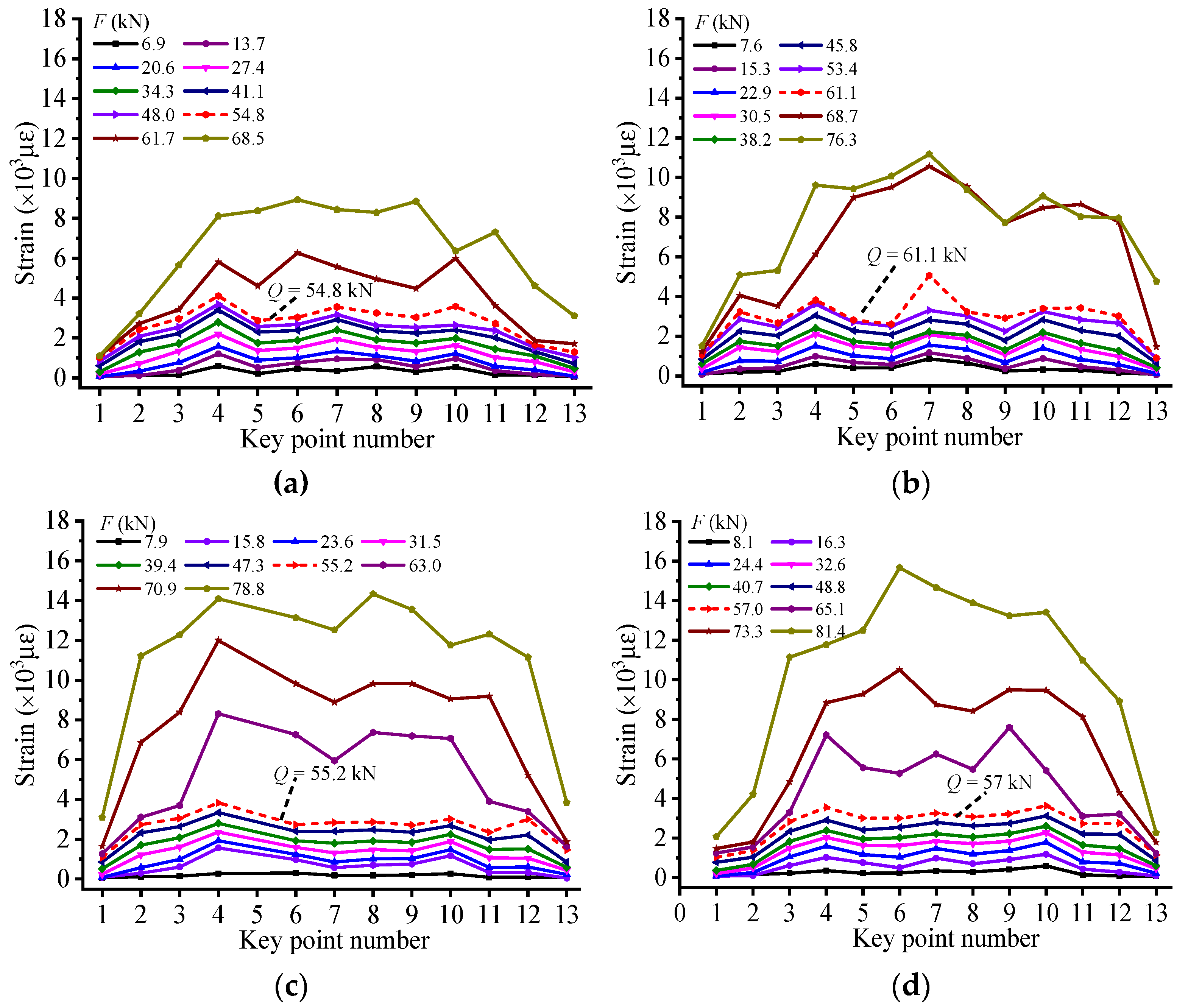
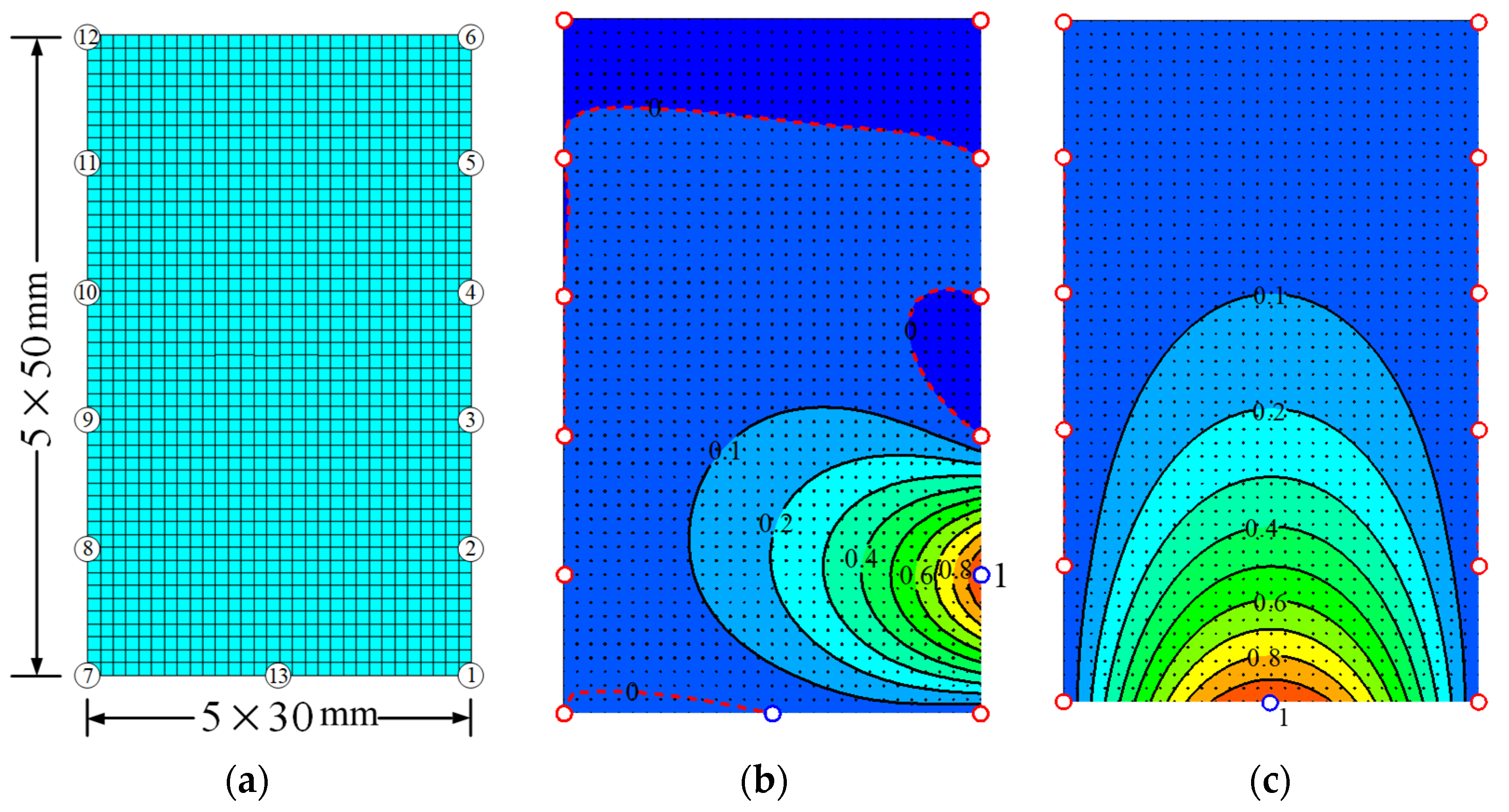
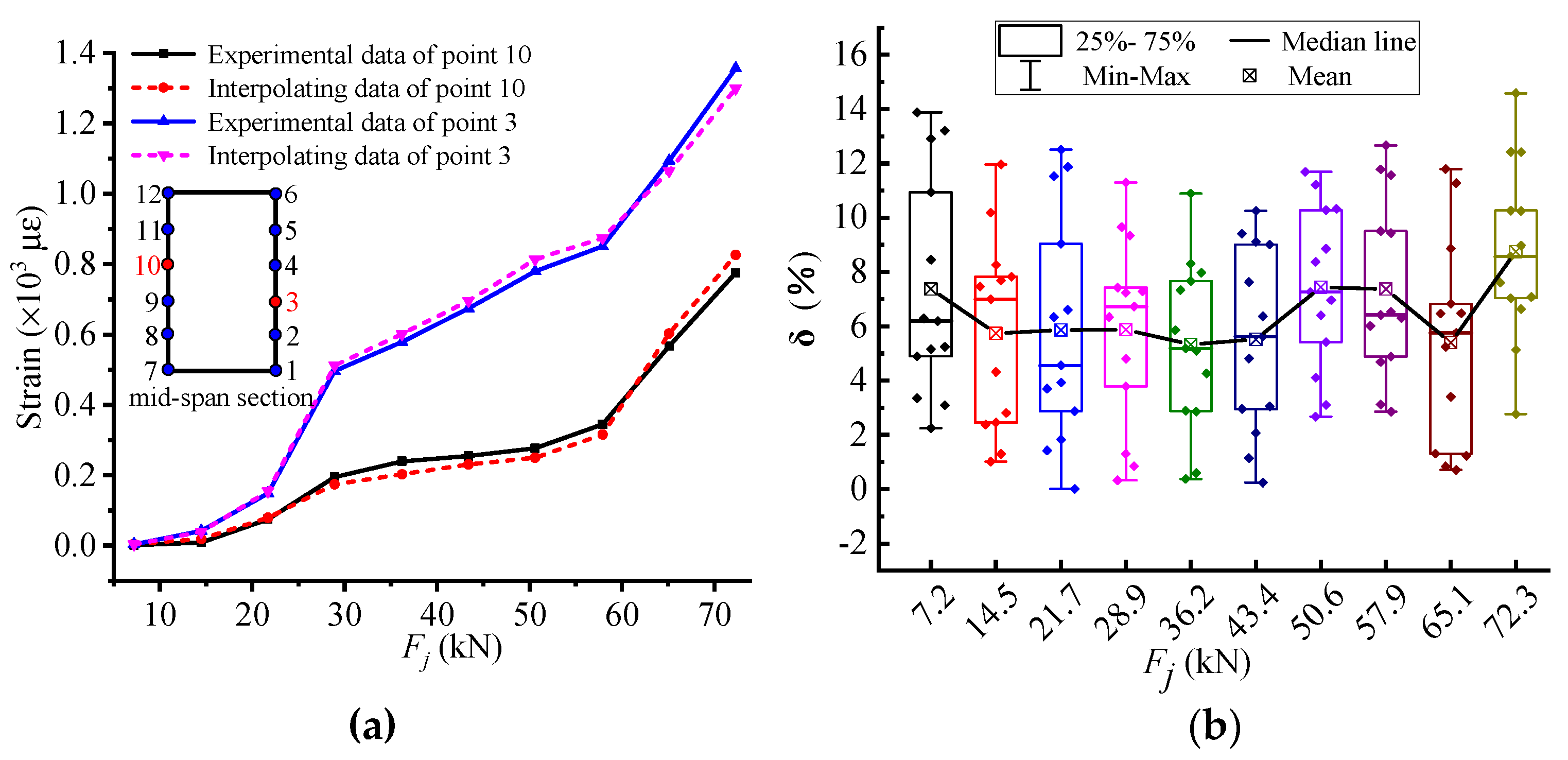
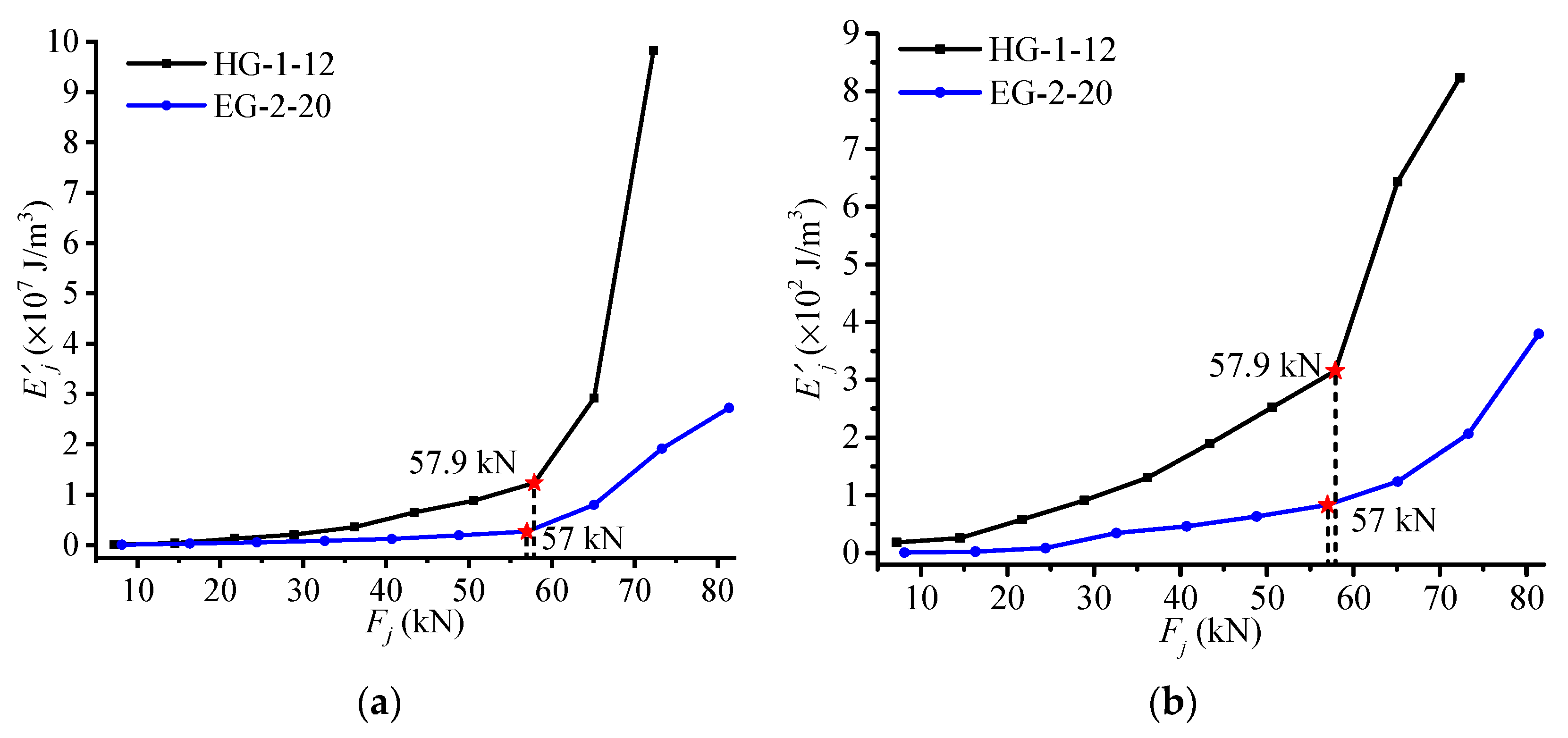
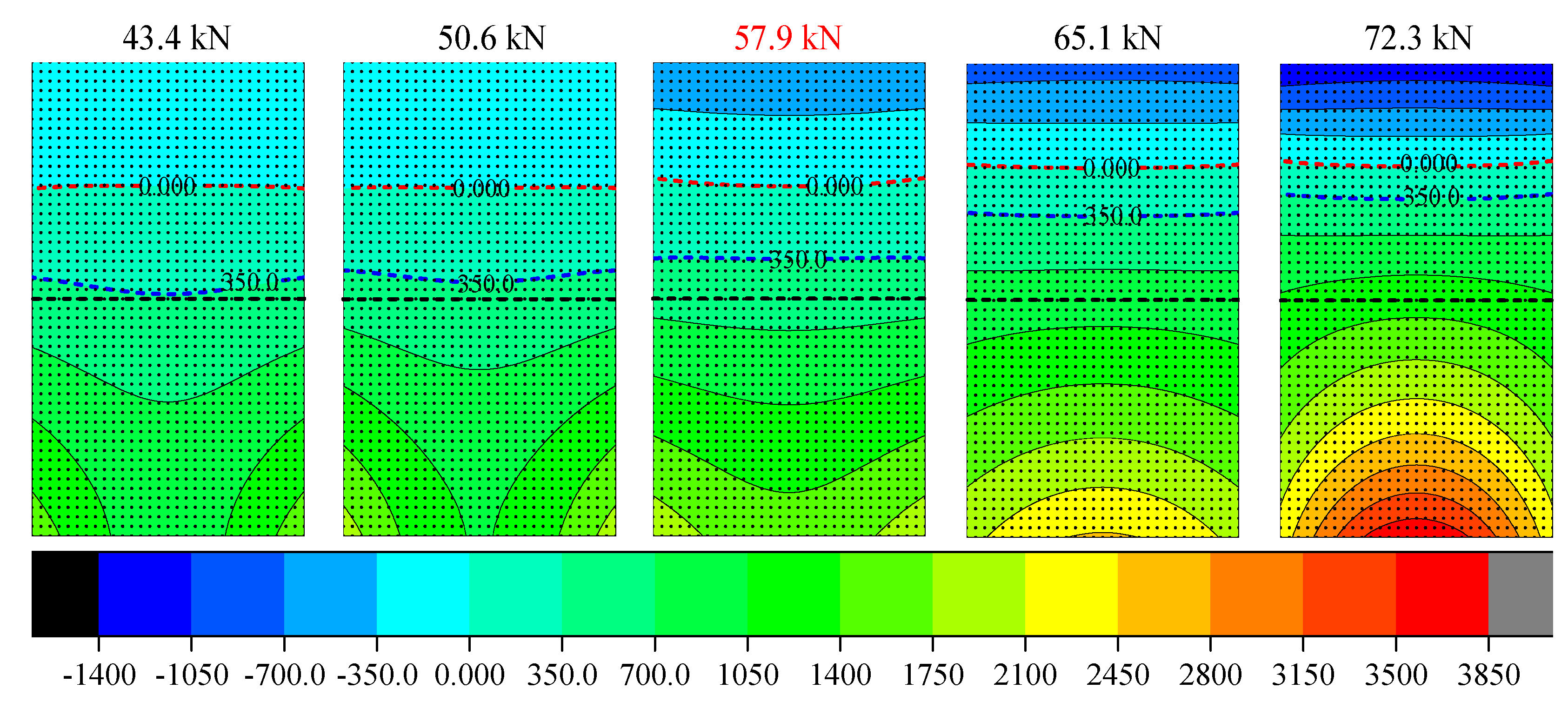
| Strength Grade | Water (kg) | Cement (kg) | Sand (kg) | Crushed Stone (kg) |
|---|---|---|---|---|
| C20 | 180 | 439 | 587.7 | 1193.3 |
| Material | Yield Stress (MPa) | Fracture Strain (με) | Fracture Strength (MPa) | Elastic Modulus (GPa) |
|---|---|---|---|---|
| Steel bar | 454.11 | \ | 620.45 | 212.13 |
| Steel plate | 291.28 | \ | 423.26 | 204.9 |
| CFRP | \ | 16,753 | 4103.4 | 270.45 |
| Middle Anchorage | End Anchorage | |||||||
|---|---|---|---|---|---|---|---|---|
| Specimen Number | CFRP Layer Number | Torque (kN·m) | Space (mm) | Number | Specimen Number | CFRP Layer Number | Steel Plate Thickness (mm) | Deformation Width-bs (mm) |
| CG-0-0 | 0 | / | / | / | EG-2-0 | 2 | 0 | 0 |
| EG-1-0 | 1 | 0 | 0 | 0 | EAG-2-10 | 2 | 5 | 10 |
| HG-1-3 | 1 | 3 | 150 | 12 | EAG-2-16 | 2 | 5 | 16 |
| HG-1-6 | 1 | 6 | 150 | 12 | EAG-2-20 | 2 | 5 | 20 |
| HG-1-12 | 1 | 9 | 150 | 12 | ||||
| Specimen Number | Cracking Point | Yield Point | Peak Point | Ductility Coefficient | ||||
|---|---|---|---|---|---|---|---|---|
| Midspan Deflection (mm) | Cracking Load (kN) | Midspan Deflection(mm) | Yield Load (kN) | Midspan Deflection (mm) | Ultimate Load (kN) | Limit Moment (kN.m) | ||
| CG-0-0 | 2.01 | 13.80 | 7.69 | 50.84 | 15.31 | 57.6 | 20.21 | 1.99 |
| EG-1-0 | 1.58 | 14.95 | 8.65 | 51.58 | 19.85 | 62.1 | 21.77 | 2.29 |
| HG-1-3 | 1.47 | 15.18 | 8.46 | 54.88 | 26.99 | 64.8 | 22.75 | 3.19 |
| HG-1-6 | 1.37 | 15.77 | 8.14 | 55.26 | 26.02 | 70.1 | 24.6 | 3.2 |
| HG-1-12 | 1.28 | 15.28 | 8.92 | 58.63 | 23.76 | 72.3 | 25.37 | 2.66 |
| EG-2-0 | 1.34 | 14.26 | 10.03 | 60.81 | 22.06 | 68.5 | 24.04 | 2.2 |
| EAG-2-10 | 1.4 | 14.84 | 10.05 | 64.21 | 27.09 | 76.3 | 26.76 | 2.7 |
| EAG-2-16 | 1.32 | 14.37 | 9.99 | 60.95 | 34.98 | 78.8 | 27.62 | 3.5 |
| EAG-2-20 | 1.39 | 14.49 | 9.93 | 61.47 | 34.29 | 81.4 | 28.55 | 3.45 |
Publisher’s Note: MDPI stays neutral with regard to jurisdictional claims in published maps and institutional affiliations. |
© 2021 by the authors. Licensee MDPI, Basel, Switzerland. This article is an open access article distributed under the terms and conditions of the Creative Commons Attribution (CC BY) license (http://creativecommons.org/licenses/by/4.0/).
Share and Cite
Luo, L.; Lai, J.; Shi, J.; Sun, G.; Huang, J.; Yuan, M. Stressing State Analysis of Reinforced Concrete Beam Strengthened by CFRP Sheet with Anchoring Device. Materials 2021, 14, 576. https://doi.org/10.3390/ma14030576
Luo L, Lai J, Shi J, Sun G, Huang J, Yuan M. Stressing State Analysis of Reinforced Concrete Beam Strengthened by CFRP Sheet with Anchoring Device. Materials. 2021; 14(3):576. https://doi.org/10.3390/ma14030576
Chicago/Turabian StyleLuo, Liang, Jie Lai, Jun Shi, Guorui Sun, Jie Huang, and Maoguo Yuan. 2021. "Stressing State Analysis of Reinforced Concrete Beam Strengthened by CFRP Sheet with Anchoring Device" Materials 14, no. 3: 576. https://doi.org/10.3390/ma14030576
APA StyleLuo, L., Lai, J., Shi, J., Sun, G., Huang, J., & Yuan, M. (2021). Stressing State Analysis of Reinforced Concrete Beam Strengthened by CFRP Sheet with Anchoring Device. Materials, 14(3), 576. https://doi.org/10.3390/ma14030576




